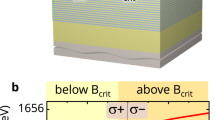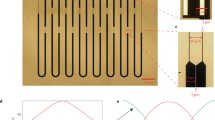Abstract
Progress in the science and technology of semiconductors has enabled physicists and engineers not only to conceive and implement new electronic, optical, and optoelectronic devices, but also to probe fundamental phenomena that emerge from new device structures. Indeed, much of the excitement of semiconductor physics stems from the interplay of fundamental investigations and practical applications. The development of quantum wells and other heterostructures has enabled the implementation of a broad range of devices based on the quantization of electronic states; i.e. it has been possible to control the electron wavefunction in crystal structures. Quite recently, the development of technology for fabricating modulated dielectric structures in semiconductors has also made it possible to control the electromagnetic field configuration in device structures. As discussed by several authors in this volume, this has opened up the possibility for numerous applications, such as “thresholdless” lasers and resonant-cavity LED’s, modulators, and detectors.
Access this chapter
Tax calculation will be finalised at checkout
Purchases are for personal use only
Preview
Unable to display preview. Download preview PDF.
Similar content being viewed by others
References
S. Haroche, in Fundamental systems in Quantum Optics, edited by J. Dalibard et. al. (Elsevier, Amsterdam, 1992), and references therein.
J.J. Sanchez-Mondragon, N.B. Narozhny, and J.H. Eberly, “Theory of Spontaneous-Emission Line Shape in an Ideal Cavity”, Phys. Rev. Lett. 51, 550 (1983).
J J. Hopfield, “Theory of the Contribution of Excitons to the Complex Dielectric Constant of Crystals” Phys Rev. 112, 1555 (1958).
R.G. Ulbrich and G.W. Fehrenbach, “Polariton Wave Packet Propagation in the Exciton Resonance of a Semiconductor,” Phys. Rev. Lett. 43, 963 (1979).
D. Fröhlich, A. Kulick, B. Uebbing, A. Mysyrowicz, V. Langer, H. Stolz, and W. von der Osten, “Coherent Propagation and Quantum Beats of Quadrupole Polaritons in Cu2O,” Phys. Rev. Lett. 67, 2343 (1991).
T. Mishina and Y. Masumoto, “Coherent Propagation of Femtosecond Optical Pulses in a Monoclinic ZnP2 Single Crystal,” Phys. Rev. Lett. 71, 2785 (1993).
K.H. Pantke, P. Schillak, B.S. Razbirin, V.G. Lyssenko, and J.M. Hvam, “Nonlinear Quantum Beats of Propagating Polaritons”, Phys. Rev. Lett. 70, 327 (1993).
S. John and J. Wang, “Quantum Electrodynamics near a Photonic Band Gap: Photon Bound States and Dressed Atoms”, Phys. Rev. Lett. 64, 2418(1990).
R.F. Nabiev. P. Yeh, and J.J. Sanchez-Mondragon, “Dynamics of the Spontaneous Emission of an Atom into the Photon-Density-of-States Gap: Solvable Quantum-Electrodynamical Model”, Phys. Rev. A 47, 3380 (1993).
R.G. Ulbrich and C. Weisbuch, “Resonant Brillouin Scattering of Excitonic Polaritons in Gallium Arsenide”, Phys. Rev. Lett. 38, 865 (1977).
U.S. Scmitt-Rink, D.S. Chemla, and D.A.B. Miller, “Linear and Nonlinear Optical Properties of Semiconductor Quantum Wells,” Adv. Phys. 38, 89 (1989).
E.T. Jaynes and F.W. Cummings, Proc. IEEE 51, 89 (1963).
L. Allen and J.H. Eberly, Optical Resonance and Two-Level Atoms (Wiley, New York, 1975).
P. Meystre and M. Sargent III, Elements of Quantum Optics, (Springer-Verlag, Berlin, 1991).
C. Cohen-Tannoudji, J. Dupont-Roc, and G. Grynberg, Atom-Photon Interactions, (Wiley, New York, 1992).
G.S. Agarwal, “Vacuum-Field Rabi Oscillations of Atoms in a Cavity”, J. Opt. Soc. Am. B 2, 480 (1985).
H.J. Carmichael, R. J. Brecha, M.G. Raizen, H.J. Kimble, and P.R. Rice, “Subnatural Linewidth Averaging for Coupled atomic and cavity-mode oscillators”, Phys. Rev. A 40, 5516 (1989).
M.G. Raizen, R.J. Thompson, R.J. Brecha, H.J. Kimble, and H. J. Carmichael, “Normal-Mode splitting and Linewidth Averaging for Two-State Atoms in an Optical Cavity”, Phys. Rev. Lett. 63, 240 (1989).
Y. Zhu, D.J. Gauthier, S. E. Morin, Q. Wu, H.J. Carmichael, and T.W. Mossberg, “Vacuum Rabi Splitting as a Feature of Linear-Dispersion Theory: Analysis and Experimental Observations”, Phys. Rev. Lett. 64, 2499 (1990).
R.S. Knox, Theory of Excitons, (Academic, New York, 1963).
P.W. Milonni and J.H. Eberly, Lasers, (Wiley, New York, 1988), section 6.4.
P.C. Becker, H.L. Fragnito, C.H. Brito Cruz, R.L. Fork, J.E. Cunningham, J.E. Henry, C.V. Shank, “Femtosecond Photon Echoes from Band-to-Band Transitions in GaAs”, Phys. Rev. Lett. 61, 1647 (1988).
L. Schultheis, A. Honold, J. Kuhl, K. Köhler, and C.W. Tu, Phys. Rev. B 34, 9027 (1986).
D.S. Citrin, “Radiative Lifetimes of Excitons in Quantum Wells: Localization and Phase-Coherence Effects”, Phys. Rev. B 47, 3832 (1993).
B. Deveaud, F. Clerot, N. Roy, K. Satzke, B. Sermage, and D.S. Katzer, “Enhanced Radiative Recombination of Free Excitons in GaAs Quantum Wells,” Phys. Rev. Lett. 67, 2355 (1991).
See the lecture notes of L.C. Andreani and D. Citrin.
G. Bastard, Wave Mechanics Applied to Semiconductor Heterostructures, (Les Editions de Physique, Paris, 1989).
Y. Yamamoto, S. Machida, and G. Bjork, “Microcavity Semiconductor Laser with Enhanced Spontaneous Emission,” Phys. Rev. B 44, 657 (1991).
L.C. Andreani, A. Pasquarello, “Accurate Theory of Excitons in GaAs-Ga1™xAlxAs Quantum Wells”, Phys. Rev. B 42, 8928 (1990).
C. Weisbuch, M. Nishioka, A. Ishikawa, and Y. Arakawa, “Observation of the Coupled Exciton-Photon Mode Splitting in a Semiconductor Quantum Microcavity”, Phys. Rev. Lett. 69, 3314 (1992).
J.L. Jewell, J.P. Harbison, A. Scherer, Y.H. Lee, and L.T. Florez, “Vertical-Cavity Surface-Emitting Lasers: Design, Growth, Fabrication, Characterization”, IEEE J. Quant. Electron., 27, 1332 (1991), and references therein.
R. Binder, S.W. Koch, M. Lindberg, N. Peyghambarian, W. Schäfer, “Ultrafast Adiabatic Following in Semiconductors”, Phys. Rev. Lett. 65, 899 (1990).
J. Shah, “Ultrafast Luminescence Spectroscopy Using Sum Frequency Generation”, IEEE J. Quant. Electron. 24, 276, (1988).
This experimental technique is similar to that discussed in D. Kim, J. Shah, D.A.B. Miller, T.C. Damen, “Femtosecond-pulse distortion in quantum wells”, Phys. Rev. B 48, 17902 (1993).
J.H. Eberly and K. Wodkiewicz, “The Time-Dependent Physical Spectrum of Light,” J. Opt. Soc. Am. 67, 1252 (1977).
Author information
Authors and Affiliations
Editor information
Editors and Affiliations
Rights and permissions
Copyright information
© 1995 Springer Science+Business Media New York
About this chapter
Cite this chapter
Norris, T.B. (1995). Strong Coupling in Semiconductor Microcavities. In: Burstein, E., Weisbuch, C. (eds) Confined Electrons and Photons. NATO ASI Series, vol 340. Springer, Boston, MA. https://doi.org/10.1007/978-1-4615-1963-8_17
Download citation
DOI: https://doi.org/10.1007/978-1-4615-1963-8_17
Publisher Name: Springer, Boston, MA
Print ISBN: 978-1-4613-5807-7
Online ISBN: 978-1-4615-1963-8
eBook Packages: Springer Book Archive




